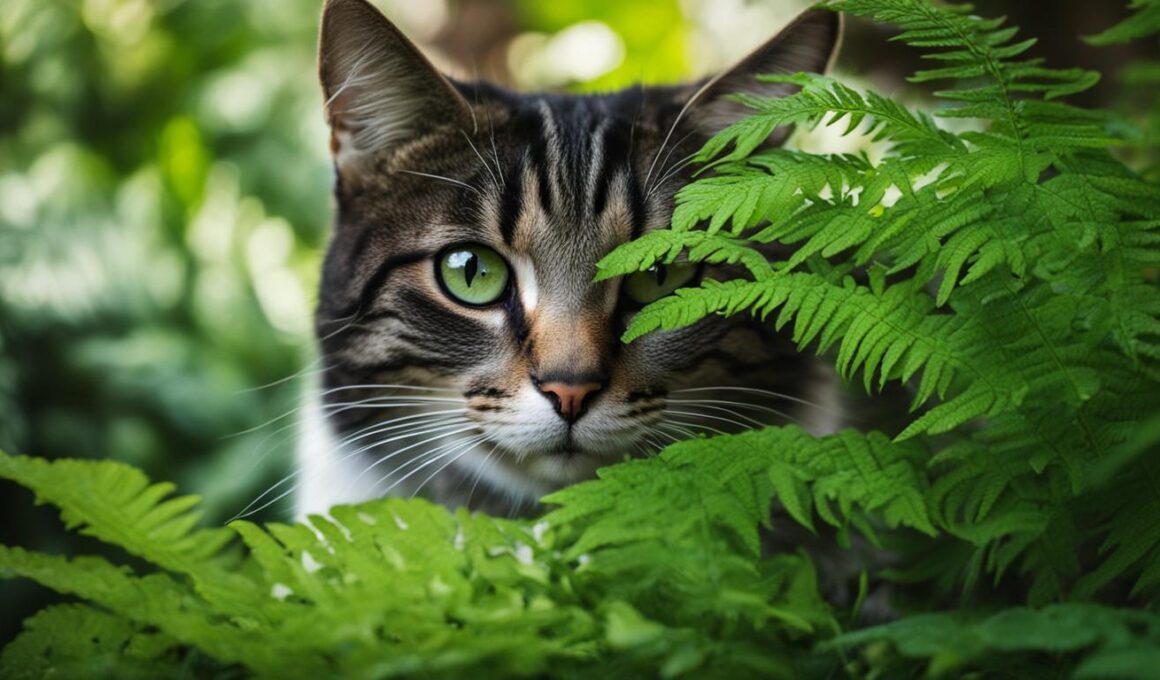When it comes to creating a safe environment for your beloved feline friend, it’s essential to consider the potential dangers that certain plants may pose. One common concern is whether ferns are poisonous to cats. Let’s delve into this topic and find out the truth.
The good news is that most ferns are not poisonous to cats. True ferns, such as Boston fern, button fern, rabbit’s foot fern, and staghorn fern, are considered safe for our furry companions. These beautiful and decorative plants can add a touch of greenery to your home without posing any toxicity risks.
However, it’s crucial to be aware of the difference between true ferns and look-alike plants that may be harmful to your cat. Some plants that resemble ferns or have “fern” in their name, such as Asparagus fern, Sprengeri fern, fern palm, and winter fern, can be toxic if ingested by cats.
Ingesting these toxic plants can lead to various symptoms, including an upset stomach, diarrhea, vomiting, and in severe cases, health issues that may require immediate medical attention. Therefore, it’s vital to be able to distinguish between safe ferns and potentially poisonous ones in order to protect your furry friend from any harm.
Stay informed and keep an eye on the types of ferns and plants in your home. By taking preventive measures and ensuring your cat’s environment is free from toxic plants, you can provide them with a safe and healthy living space.
Types of Toxic Plants for Cats
In addition to ferns, there are other common houseplants that can be toxic to cats if ingested. It’s important for cat owners to be aware of these plants and take necessary precautions to keep them away from their pets.
- Pothos: This popular trailing plant contains insoluble calcium oxalate crystals, which can cause oral irritation and digestive issues in cats.
- Tulips: These beautiful flowers contain allergenic lactones that can cause gastrointestinal upset and even more severe symptoms in cats.
- Aloe Vera: While aloe vera has medicinal properties for humans, it can be toxic to cats, causing vomiting, diarrhea, and changes in urine color.
- Peace Lily: Also known as Spathiphyllum, peace lilies contain calcium oxalate crystals and other compounds that can cause oral irritation, difficulty swallowing, and digestive problems in cats.
- Mother-in-Law Plant (Snake Plant): This popular houseplant contains saponins, which can cause drooling, vomiting, and diarrhea in cats. In rare cases, it can lead to more severe symptoms like kidney failure.
These plants can cause various symptoms such as oral irritation, increased salivation, difficulty swallowing, vomiting, diarrhea, and in some cases, kidney failure or death. It’s crucial to be aware of the dangers these plants pose to your feline companions and take proactive steps to prevent ingestion.
What to Do If Your Cat Ingests a Toxic Plant
If your cat ingests a toxic plant, immediate action is crucial to ensure their safety and well-being. Promptly contact your veterinarian for guidance and the best course of action. Remember, time is of the essence when dealing with potential toxin ingestion.
When you call your vet, provide them with all the relevant information, including the name of the plant, picture if possible, and the time of ingestion. This information will help the vet understand the severity of the situation and guide their recommendations.
In some cases, your veterinarian may need to assess your cat in person to evaluate their condition accurately. They may request you to bring a sample of the plant for analysis. This step is critical in determining the specific toxins involved and tailoring the treatment accordingly.
- Rinsing the mouth and skin: In mild cases, your vet may advise rinsing your cat’s mouth and skin with water to remove any remaining toxins and irritants. This can help prevent further absorption and reduce potential harm to your cat.
- Intravenous fluids for hydration: Depending on the severity of the ingestion, your cat may require intravenous fluids to maintain proper hydration. This helps flush out toxins from their system and supports their overall recovery.
- Administering medications: Your veterinarian may prescribe medications to address any symptoms or reactions caused by the toxic plant ingestion. These medications can help alleviate discomfort, reduce inflammation, and promote recovery.
Throughout the recovery process, it is essential to closely follow your veterinarian’s instructions. Monitor your cat’s behavior, appetite, and overall well-being vigilantly. Report any concerns or changes to your vet immediately, as they may indicate a need for further treatment or intervention.
Remember, each case of toxic plant ingestion can vary in severity, and the appropriate treatment may differ. Consulting with a veterinarian ensures that your pet receives the necessary care tailored to their specific needs.
Can Dogs Be Harmed by the Same Plants That Are Poisonous to Cats?
Yes, dogs can be harmed by the same plants that are poisonous to cats, including wisteria. Wisteria poisoning in dogs can lead to symptoms such as vomiting, diarrhea, and lethargy. It’s important to keep these toxic plants away from your pets and seek veterinary help if ingestion occurs.
Conclusion
While most ferns are safe for cats, it’s crucial for cat owners to be knowledgeable about the types of ferns and plants that can be toxic to their pets. Prevention is key in ensuring the health and safety of your furry friends.
To keep your cat safe, make sure to keep toxic plants out of your home or place them out of your cat’s reach. By doing so, you can minimize the risk of accidental ingestion and potential harm. Additionally, having a first aid kit and emergency phone numbers, such as those for a pet poison hotline and your veterinarian, readily available can provide quick assistance in case of a poisoning emergency.
Being proactive in educating yourself about fern safety and toxic plants is crucial for the well-being of your cat. Regularly inspect your home and outdoor spaces to identify any potentially hazardous plants and take appropriate measures to prevent your cat from coming into contact with them. By taking these preventive measures, you can help maintain a safe and healthy environment for your beloved feline companion.









